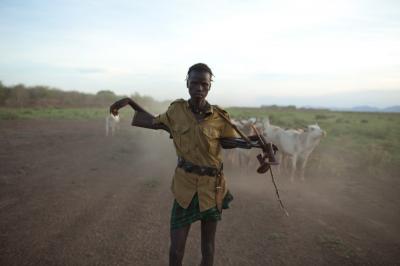As drought brings increasing instability to the region, the control of small arms becomes a problem of increasing urgency.
By Alasdair Reid
 Turkana, Kenya:
Turkana, Kenya:
On a recent trip to Turkana in northern Kenya, somewhere between Maralal and Baragoi we stopped by a dry riverbed. A group of 12 men came into view through the desert scrub. As they drew closer their weapons were clearly visible, a mix of AK47s, ex-government issue G3s and a few older rifles. Our nervousness was unwarranted and the group barely slowed as they passed, merely raising their hands in greeting before continuing on towards some distant assignment. Further down the road we passed a small town with freshly dug graves. The dozens of mounds covered with fresh earth an alarming reminder of the effects of small arms and of the violence that is so endemic in many parts of the north.
As Kenya and the horn is hit with a prolonged period of drought, the fear is that the usual rounds of cattle theft could escalate into a much larger problem, indeed, humanitarian actors in the region have been reporting significant increases in violence in the last few months. As cattle die of starvation in unprecedented numbers, raids are mounted to replace lost stock from neighbouring areas; these thefts ignite reprisals which have led to a surge in ethnic conflict and a ramping up of the general tension and the demand for small arms in the region.
Arms Smuggling and Cross-border Conflict
On 17 August three Ethiopian nationals were arrested in Moyale for smuggling 2000 rounds of ammunition across the border. This arrest came after a number of high-profile killings and bandit attacks in the area and it highlights the continued difficulties the Kenyan government have had in preventing weaponry from crossing the long and porous borders to their North and East. Arms also regularly cross the border from Northern Uganda and Sudan and there have been recent reports by the UN security services of Somalian Transitional Federal Government troops deserting in large numbers across the border and selling their weapons. Tensions and the easy availability of weapons leads to local arms races and to the increasing severity and commercialisation of cattle-raiding, piracy and banditry.
A UN security assessment the end of August 2011 awarded the Northern Rift Valley and the North Eastern region with its highest category of substantial risk. The total death toll in violence involving small arms in the area is difficult to estimate but the official figures for cattle-raiding incidents alone between January and June 2011 is 125 – with the actual total likely to be far higher. Conflicts in the area are complex and difficult to track as many ethnic groups like the Samburu, the Boran, the Turkana and the Pokot as well as groups from northern Uganda’s Karamajong district, Southern Sudan, Ethiopia and Somalia are involved in an almost constant cycle of bloody retributions and cattle-raiding in the region. A report by LTDG puts the number of people displaced by pastoral conflict in the North of Kenya at 164,457 – a figure which perhaps better reveals the human and economic costs of the clashes. A UNDP briefing points out that escalating pastoral conflicts, especially in Africa, have often “proved devastating to the socio-economic and development trajectories of entire regions”. With this in mind, how much is being done by the Kenyan government to combat the widespread availability of the firearms that contribute so heavily to the severity of the violence?
It is over 11 years since the government signed the Nairobi Protocol on small arms and light weapons, which was designed to regulate and help prevent their spread across East Africa. In June 2005, member states established a Regional Centre on Small Arms and by March 2010, Kenya had destroyed over 25,000 illegal firearms and electronically marked about 25,000 more. This may seem like substantial progress but the amounts of weaponry confiscated falls far short of set targets and, relative to the estimated number of unlicensed weapons in the region, is a fairly minor step.
Coordinating Gun Control
Despite recent increases in the budget to combat violence and arms proliferation in the Northern regions, the general response amongst NGOs and arms control experts is that action against proliferation by the government has so far been largely unsuccessful. Indeed, the Kenyan Action Network on Small Arms (KANSA) has accused the government in a recent statement of “paying only lip service to the protocol”. They point out that the “draft policy, which was started in 2005 and completed in July 2009, is still shelved at the Ministry of Internal Security waiting cabinet approval, despite having been validated by a wide range of stakeholders”.
Confiscating weaponry and burning small arms in public is a good start and good publicity but efforts to disarm the northern regions are bound to fail unless seizures are coordinated with neighbouring countries and accompanied by measures to guarantee the security of the vulnerable communities who have opted to arm themselves for self-defence. Seizures of weapons have largely been uncoordinated and they will remain largely ineffective as long as there is a cheap and steady source of small arms and continued instability in the area. With the cost of a rifle falling from 30 to 100 cows in the 1970s to three to six cows more recently, and with bullets being used as a form of currency in some remote parts of the country, it will take more than a few scattered seizures to clean up the problem.
The problem is not simply about guns and any solution must simultaneously address underlying tensions and regional stability issues. The first step would be to promote enhanced cooperation and regulation: alongside continuing to confiscate and regulate civilian-held small arms, the government must fully commit to the promises of the Nairobi treaty and begin to adhere more tightly to UN best practices in arms control. They must also foster greater regional coordination to help combat the extensive cross-border trade. Any solution must also address the communities affected by the violence. Strengthening traditional conflict mediation techniques and providing alternatives to violent retribution could help communities to prevent escalating spirals of conflict. Community based initiatives like this have seen some success in the Wajir district, and are a model that could be adapted and expanded.
The unfortunate truth is that neither of these approaches will be likely to work unless they function as part and parcel of a broader programme to reduce the instability, impoverishment and political marginalisation of the region. With Somalia next door and the current food security crisis in full swing this is no simple task, and anyone brave enough to take it on may well have to confront the difficult question of whether existing pastoral practices in Kenya are really sustainable or desirable in their current form.

